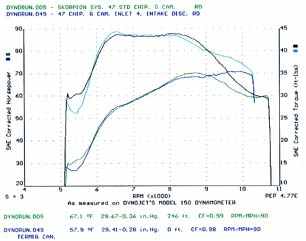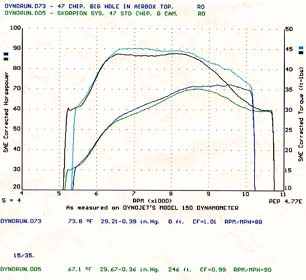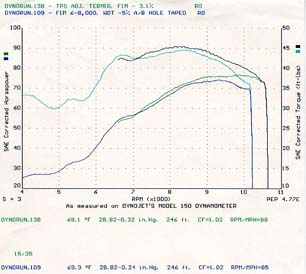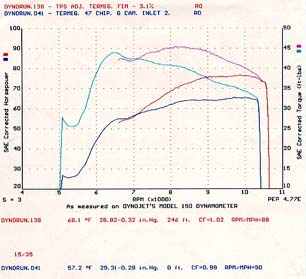|
The Dyno tests prior to Daytona were based entirely on the Termignoni pipe supplied with the
bike. I knew from previous experience that this pipe would not be quiet enough for a Euro championship noise test, I got hold of a Skorpion (Akropovic) muffler, the same as used by Alan Cathcart, to try out.
 Dyno charts 5 and 49 show the difference between the power produced, minus the rubber air conveyors, with the
Termignoni and the Skorpion, there are no other changes, it is a measure of how important back pressure is to a Ducati engine, remember this engine is half an eight valve V twin, the lesson is
therefore just as valid for those V twins. A major change in the power delivery is obvious, an after market supplier could easily claim that the Skorpion made more power. The loss in power band
width is a disaster for a racer, as far as I was aware most competitors in Euro Supermono used the Skorpion, the reasons for the Ducati's loss of form suddenly started to look obvious. Dyno charts 5 and 49 show the difference between the power produced, minus the rubber air conveyors, with the
Termignoni and the Skorpion, there are no other changes, it is a measure of how important back pressure is to a Ducati engine, remember this engine is half an eight valve V twin, the lesson is
therefore just as valid for those V twins. A major change in the power delivery is obvious, an after market supplier could easily claim that the Skorpion made more power. The loss in power band
width is a disaster for a racer, as far as I was aware most competitors in Euro Supermono used the Skorpion, the reasons for the Ducati's loss of form suddenly started to look obvious.
The Skorpion is much bigger externally than the Termignoni so it seemed likely that the
additional packing would make it quiet enough for the Euro races, I got a good friend who specialises in one off exhausts to build different internals into the outer casing of the Skorpion.
 We then revisited the Dyno-jet, still not as good as the original Termignoni we had nevertheless got back a substantial
amount of the ability to make power at high revs. FIM rules require a closed airbox and provide a limit on the size of the air opening, even removing the air conveyors did not get us anywhere near
the limit so I decided that additional venting was in order. A wide 'letterbox' hole was cut in the top of the airbox, we kept enlarging it until the bike stopped making more power, the final 'big hole'
box made more power than the airbox top off version, curves 73 and 5 show the improvement. We had finally started to get some positive airbox pulsing (or more likely, as we had no
inlet tubes the residual part of the airbox, directly above the throttle body, was providing some sort of reflective wave down through the throttle body). In this form we set off for Donington SBK. We then revisited the Dyno-jet, still not as good as the original Termignoni we had nevertheless got back a substantial
amount of the ability to make power at high revs. FIM rules require a closed airbox and provide a limit on the size of the air opening, even removing the air conveyors did not get us anywhere near
the limit so I decided that additional venting was in order. A wide 'letterbox' hole was cut in the top of the airbox, we kept enlarging it until the bike stopped making more power, the final 'big hole'
box made more power than the airbox top off version, curves 73 and 5 show the improvement. We had finally started to get some positive airbox pulsing (or more likely, as we had no
inlet tubes the residual part of the airbox, directly above the throttle body, was providing some sort of reflective wave down through the throttle body). In this form we set off for Donington SBK.
Following Callum Ramsay's win at that event, the only Ducati victory in the history of the SBK
supported European SuperMono Cup, the steam should have gone out of the project but we were noticed and managed to obtain the loan of a 60mm throttle body. This was disappointing in
tests with the standard inlet length, I would bet on more power, albeit further up the rev range if we could get it to carburet and modify the airbox for a shorter inlet length, it also put in
perspective the superb way that our present modified throttle body was working. At the same time we decided to move to the later Corsa cam, the 431 grind, to give the valves an easier
time. This latter mod was a reaction to changing the half rings every other session at Donington due to Ramsay's 'change down four gears at once' corner entry style.
 The Anti hop clutch fitted for Daytona practice came back for Donington.
Callum was changing down four gears for the Melbourne loop and we fitted the (slightly modified) clutch for the race. I am not convinced it worked very well though as later in the year we began to
get more accurate at shimming the clutch springs out to allow the clutch to Anti-hop earlier and more smoothly. The Anti hop clutch fitted for Daytona practice came back for Donington.
Callum was changing down four gears for the Melbourne loop and we fitted the (slightly modified) clutch for the race. I am not convinced it worked very well though as later in the year we began to
get more accurate at shimming the clutch springs out to allow the clutch to Anti-hop earlier and more smoothly.
The above charts do not take into account all the little changes in mixture
needed to get the best power, in this the adjustable EPROMS were proving invaluable, while we could build an engine to an accurate spec, there were still things outside of our control that affected
mixture. The ability of the hand held computer to adjust overall fuel maps, let alone small sections was proving invaluable in obtaining the clean stumble free performance needed to get the bike out of corners
fast. Curves 138 and 109 show the best power made with the Termignoni and Akropovic pipes.
Further experimentation with squish, valve seat cutting, compression and cam timing brought
about this final curve, shown here in both 'modified Skorpion' and Termignoni versions, compared with the original 'airbox system in one piece' curve. There was only one part inside
the bike (the inlet cam) not originally provided with the bike; the rest is down to careful modification, accurate assembly, precise set-up and the correct mix of parts.
 Compare the final Termignoni curve with the start of the year. Feel free to compare these with those for a 1999
Ducati 900ss, not bad for a five-year-old, 280 lb., 572cc single! A street version would definitely weigh more and make a little less power but we could get one within 6 bhp of this one, and it
would be really brilliant in the twisties. Compare the final Termignoni curve with the start of the year. Feel free to compare these with those for a 1999
Ducati 900ss, not bad for a five-year-old, 280 lb., 572cc single! A street version would definitely weigh more and make a little less power but we could get one within 6 bhp of this one, and it
would be really brilliant in the twisties.
Neil Spalding
|